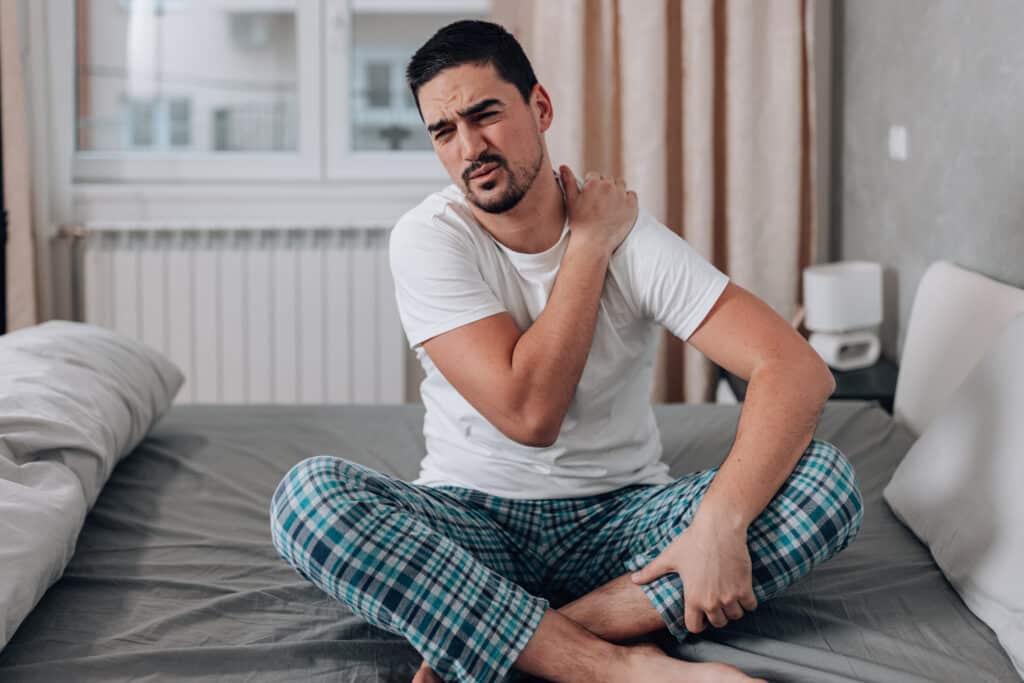
Shoulder bursitis, a condition characterized by inflammation of the bursa—a small, fluid-filled sac that acts as a cushion between bones and soft tissues—can be a source of significant pain and discomfort. One common question that arises among those suffering from this condition is whether inactivity can exacerbate the symptoms of shoulder bursitis. This blog post will explore this question in detail, shedding light on the role of physical activity in managing shoulder bursitis and highlighting how CARESPACE Health+Wellness can provide a comprehensive, multidisciplinary approach to treatment.
Understanding Shoulder Bursitis
Before delving into the effects of inactivity on shoulder bursitis, it’s important to understand the condition itself. Bursae are located throughout the body, providing cushioning and reducing friction between tissues. When these sacs become inflamed, usually due to repetitive motion, overuse, or direct trauma, the resulting condition is known as bursitis. In the shoulder, bursitis often occurs in the subacromial bursa, which lies between the rotator cuff tendons and the acromion (part of the shoulder blade).
Common symptoms of shoulder bursitis include:
- – Pain and tenderness, particularly when moving the shoulder
- Swelling and redness in the affected area
- Reduced range of motion
- Discomfort when lying on the affected side
The Impact of Inactivity on Shoulder Bursitis
Inactivity can have a profound effect on shoulder bursitis, often leading to worsening symptoms. Here are several reasons why inactivity can be detrimental, possibly causing shoulder bursitis to become serious:
1. Stiffness and Reduced Mobility: Lack of movement can cause the shoulder joint to become stiff, reducing its range of motion. This stiffness can exacerbate pain and make daily activities more difficult.
2. Muscle Weakness: Muscles surrounding the shoulder joint may weaken without regular use. Weak muscles provide less support to the joint, potentially increasing the strain on the bursa and aggravating the inflammation.
3. Circulation Issues: Physical activity promotes blood circulation, which is essential for healing. Inactivity can slow down the recovery process by reducing blood flow to the affected area, hindering the delivery of essential nutrients and oxygen.
4. Chronic Pain Cycle: Prolonged inactivity can lead to a cycle of chronic pain. As pain leads to further avoidance of movement, the condition can become more entrenched and harder to treat.
The Role of Physical Activity in Managing Shoulder Bursitis
Contrary to the belief that rest is the best remedy for shoulder bursitis, controlled and targeted physical activity can be highly beneficial. Exercise and movements aim to strengthen the muscles around the shoulder, improve flexibility, and enhance blood circulation, all of which contribute to reducing inflammation and pain. However, it’s crucial that these activities are performed correctly and under professional guidance to avoid further injury.
How CARESPACE Can Help
CARESPACE Health+Wellness adopts a multidisciplinary approach to treat shoulder bursitis, combining the expertise of various health professionals to create a personalized, coordinated plan of care. This integrative approach ensures that all aspects of the condition are addressed, promoting faster and more effective recovery.
Physiotherapy and Chiropractic Care
At CARESPACE, physiotherapists and chiropractic doctors work together seamlessly to manage shoulder bursitis. Here’s how their collaboration benefits clients:
Assessment and Diagnosis: The first step in treating shoulder bursitis at CARESPACE involves a thorough assessment by both physiotherapists and chiropractic doctors. This comprehensive evaluation helps identify the underlying causes of bursitis and any contributing factors such as posture issues, muscle imbalances, or previous injuries.
Customized Exercise Programs: Physiotherapists design personalized exercise programs to strengthen the shoulder muscles, improve flexibility, and restore range of motion. These exercises are tailored to the individual’s condition and are adjusted as they progress. By engaging in these targeted exercises, clients can alleviate pain and prevent future episodes of bursitis.
Manual Treatment: Chiropractic doctors at CARESPACE use manual techniques such as joint mobilizations and adjustments to improve shoulder function and reduce pain. These hands-on treatments help release tension in the muscles and improve joint alignment, facilitating better movement patterns.
Education and Self-Management: Both physiotherapists and chiropractic doctors educate clients about their condition and provide guidance on self-management strategies. This includes advice on ergonomics, posture correction, and activity modification to prevent aggravation of symptoms. By empowering clients with knowledge, they can make informed decisions about their daily activities and avoid actions that may worsen their condition.
A Comprehensive Approach to Healing
The collaborative efforts of physiotherapists and chiropractic doctors at CARESPACE are complemented by other practitioners, such as RMTs, kinesiologists, and naturopathic doctors. This team-based approach ensures that every aspect of the client’s health is considered, leading to a holistic and effective treatment plan.
Massage: RMTs at CARESPACE provide massage to relieve muscle tension, improve circulation, and enhance overall relaxation. This can be particularly beneficial for individuals with shoulder bursitis, as it helps reduce pain and promotes healing.
Kinesiology: Kinesiologists work with clients to develop personalized exercise programs that focus on strength, flexibility, and functional movement. These programs are designed to complement the treatments provided by physiotherapists and chiropractic doctors, ensuring a well-rounded approach to recovery.
Naturopathic Medicine: Naturopathic doctors at CARESPACE offer natural and holistic treatments to support the body’s healing process. This may include dietary recommendations, herbal supplements, and other natural treatments that reduce inflammation and promote overall well-being.
In conclusion, inactivity can indeed make shoulder bursitis worse by leading to stiffness, muscle weakness, and reduced circulation. However, a well-structured and guided physical activity program can significantly improve the condition. At CARESPACE Health+Wellness, the collaborative efforts of physiotherapists, chiropractic doctors, and other health professionals provide a comprehensive and effective approach to managing shoulder bursitis. By combining their expertise, these practitioners create personalized, multidisciplinary plans of care that address the root causes of bursitis and promote long-lasting recovery. If you’re struggling with shoulder bursitis, consider reaching out to CARESPACE for a holistic and coordinated treatment plan that can help you achieve your health goals.




